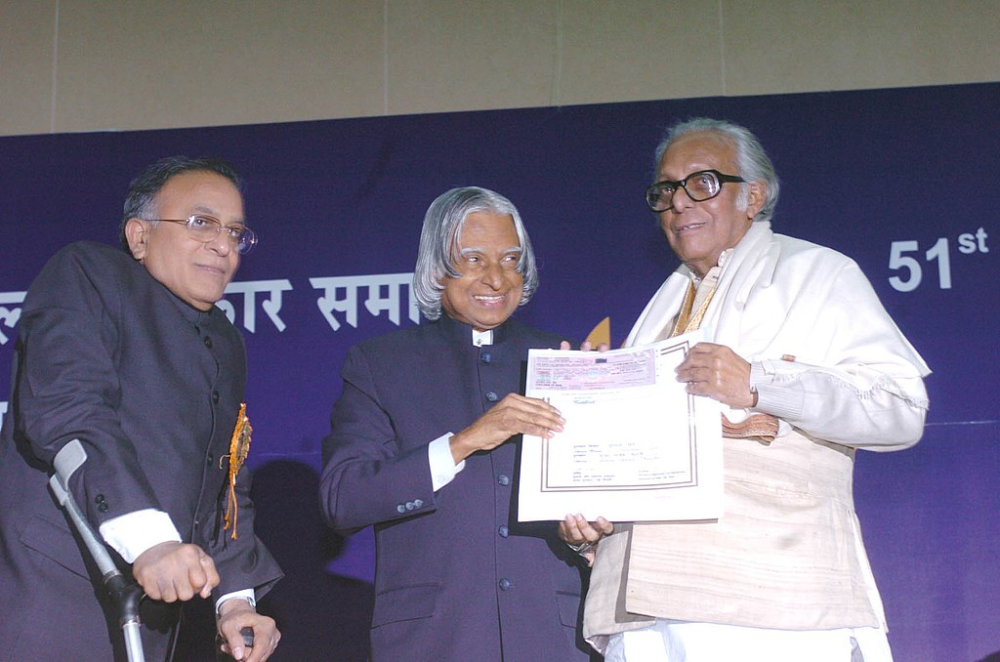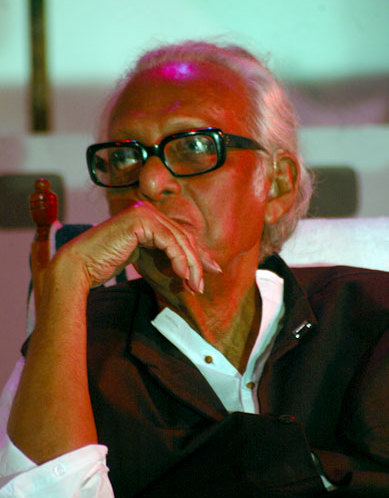Along with Satyajit Ray and Ritwik Ghatak, Mrinal Sen was one of the three iconic Bengali film-makers of the 20th century. He not only influenced a generation of political film-makers in India, but also introduced Indian films to a global audience. Here we look at Sen’s ideology, the politics in his films and why he chose to make movies for the ‘scattered minority audience around the world’. (Photo Courtesy: V.K. Cherian)
‘I (was born out of) an accident, long back, 90 years ago, on 14 May, my birth day. I am now waiting for another accident, a major accident, and I hope I can take it gracefully,’ said a ninety-year-old Mrinal Sen. Sen had plans to make a film with Soumitra Chatterjee and Naseeruddin Shah. He also had a bank loan offer of Rs 5 crore with which he could make six more films. However, these did not materialise due to his failing health. The challenges of time and period remained as interesting and exciting as ever for the iconic film-maker. Indeed, Sen took the second ‘accident’ of his life gracefully on December 30, 2018, leaving a rich legacy of his films for future generations.
At the time, Sen was the only surviving member of the three globally renowned auteurs from Bengal (the other two being Satyajit Ray and Ritwik Kumar Ghatak). The triumvirate not only pioneered the ‘parallel cinema’ genre in India, but also placed Indian films firmly on the map, influencing a generation of film-makers across the world. ‘I always valued Mrinal da’s opinion on my films,’ wrote Adoor Gopalakrishnan, the renowned Malayalam film-maker, in an obituary for Sen in the Malayalam journal Mathrubhumi. ‘After seeing my film Rat Trap, Mrinal da asked me whether I had gone through a very difficult phase of my life. I was surprised and asked him how does he know about it. He said, it is there in the film.’[i]

Winner of countless national and international awards, including the Dadasaheb Phalke award and Padma Bhushan, Sen was also nominated as a member of the Rajya Sabha (In pic: A 2005 picture of the then president A.P.J. Abdul Kalam presenting the Dada Saheb Phalke Award to Sen, with Union Minister for Information and Broadcasting S. Jaipal Reddy on the left. (Courtesy: Ministry of Information & Broadcasting [GODL-India])
Mrinal da—as he was fondly called by his admirers—also initiated the ‘new wave’ in Hindi films with Bhuvan Shome. He joined hands with the Pune Film Institute (later called FTII) graduates and the Bombay film society ‘Film Forum’, founded by Khwaja Ahmad Abbas in 1964, to come out with a manifesto for a ‘new wave’ of films, which made Indian movies regular features at international film festivals.
Born in 1923 in the small town of Faridpur in modern-day Bangladesh, Sen immigrated to Kolkata with his family—which included 12 siblings—in the 1940s. He was not only witness to the great Bengal famine during World War II but also to the funeral of Rabindranath Tagore—two incidents that impacted Sen’s creative vision. The politics of poverty and human relations remained his favourite subjects and were present in all his films. Sen’s directorial debut came with Raat Bhore (The Dawn) in 1955, after which he went on to direct 31 feature films and documentaries. The winner of countless national and international awards, including the Dadasaheb Phalke award and the Padma Bhushan, he was also made a member of the Rajya Sabha.
Also Read | Satyajit Ray and His Two Powerful Female Mentors
Sen was a proud product of the ‘Indian film society’ movement and owed his existence to the ‘minority’ audience across the globe. ‘Parents are very important for a child to grow. Film societies have been very important for me to grow’—that was how he described the role of such societies in film creativity. He was not only president of the Federation of Film Societies of India (FFSI) after Ray’s death, but later helmed several international film clubs as well.
Sen’s vision for his work was always very clear and that it was not glamour but creativity that guided him as a film-maker (Courtesy: Indian Diplomacy/Youtube)
Sen’s vision for his work was always very clear. It was not glamour but creativity that guided him as a film-maker. He clearly segregated the box office and his kind of films (which would often be categorised as parallel cinema), for which he gained admirers not just in India but across the world. In an interview, he said:
'You cannot expect [a] large number of people to see your films. Any sensible film-maker, when he makes films, his films are not that reachable to everyone … For instance, in fiction, if you read novels … Not all novels are very popular. Popular novels are very different … Even then I want to be popular … But I am a popular failure most of the time … in the box office. But then that is why my arithmetic is very simple ... I make low budget films … If you make low costs films and … can get to the larger minority audience scattered across the world … who would be seeing your film … that way I keep going … That is in spite of the fact that I am a popular failure at the box office …' [ii]

While his films were not necessarily for a political formation in its strict form, Sen was unquestionably the pioneer of political films in India (Courtesy: Riyaz Ahamed; Creative Commons)
Sen was unquestionably the pioneer of political films in India. His films were not necessarily political, but he was always influenced by politically sensitive subjects rooted in the upheavals of Kolkata. ‘Films like literature and other media, has [sic] a certain role in our society. It creates [a] certain climate. It may also provoke a certain kind of debate’, he said in an interview published in Mrinal Sen-er Filmyatra (2015).[iii]
Also Read | Is There an Indian Way of Film-Making?
Sen, however, expanded the definition of political films to include those on ‘man–woman relations’. ‘I make films, I make films about situation[s] around me … And what is political and not political that I do not know. You can make a relationship between a man and women politically. To make films politically and make political films are two different things.’[iv]
Sen was undoubtedly an iconic director whose films evolved as he aged. Though he is considered a political film-maker, he claimed to simply depict his surroundings. Later in life, Sen felt that each of his films was a dress rehearsal for a better film and believed in ‘correcting (his) own conclusions’. He kept saying that his first film was not a good one and out of the 27 feature films he made, he thought that only 15 were worth digitalising for a retrospective at the prestigious Cannes film festival. Clearly over the five decades of creativity, his bhuvan (world) kept expanding from films such as Bhuvan Shome to his last feature film, Amar Bhuvan (My World, 2002).
This article was also published on The Indian Express.
Notes
[i] Adoor Gopalakrishnan, ‘Farewell, Mrinal Da’, Mathrubhumi (Malayalam), vol. 373 (2019).
[ii] Mrinal Sen, interview by the author, Kolkata, June 2, 2012.
[iii] Shiladitya Sen, Mrinal Sen-er Filmyatra (Kolkata: Pratikshan Publication, 2015).
[iv] Mrinal Sen, interview by the author, Kolkata, June 2, 2012.
[v] ibid.












